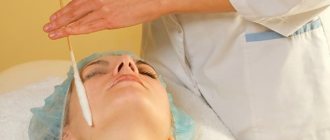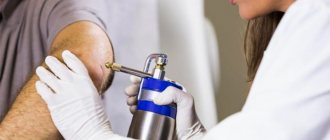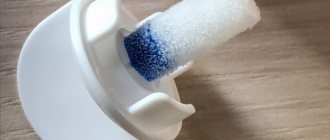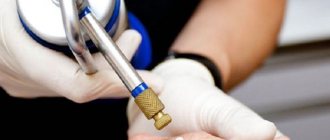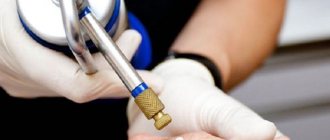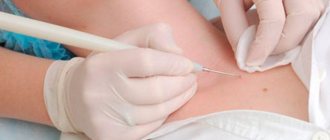Treatment of alopecia areata with cryotherapy
The content of the article
For focal alopecia, superficial freezing using the deep “Deep steak” method, contact method or spray method is used.
Freezing a swab immersed in liquid nitrogen combined with pressure is done by rolling it over the skin for about 5-7 seconds. Freeze by contact or spray method for 5-10 seconds. once or twice. Cryotherapy is repeated 1-2 times a week in 4-8 week cycles or every other day 15 times per cycle.
Treatment of alopecia areata with cryotherapy
The cycles should be repeated four times with monthly breaks. The results of cryotherapy for alopecia areata are encouraging. However, the procedures should be carried out very carefully, because even a short-term excessive drop in temperature can damage the hair follicles. So the “Deep steak” method remains the safest. You can also freeze areas of baldness with ethyl chloride 2 times a week (regrowth takes place after about 10-12 freezes).
Possible consequences
Nitrogen burns can vary in severity. Complications after skin damage occurs are also varied :
- Blackening of the skin at the burn site. This is due to the death of the top layer of skin. In rare cases, even after treatment, the skin color at the burn site remains darker than in unburned areas,
- Changes in the eye due to burns of its mucous membrane. Often there is a significant decrease in visual acuity. In severe cases, there is complete loss of vision,
- Wound infection , which is manifested by severe throbbing pain, swelling, redness, local increase in temperature in the wound area,
- Sepsis occurs when an infection from a wound enters the general bloodstream and spreads throughout the body. In this case, general hyperthermia, deterioration of health, multiple organ failure,
- A state of shock develops with deep and extensive burns,
- Scars . Hypertrophic, colloidal scars may remain.
Cryotherapy for acne vulgaris and rosacea
For acne vulgaris and rosacea, pustular, papular and larger cysts are suitable for cryosurgery. Blackheads cannot be treated with cold.
Best results are achieved using the 2-5 second spray method for small and superficial lesions, up to 5-20 seconds for larger cysts. Shallow lesions and cysts on the skin of the torso and chest respond best to treatment.
Using the Spray Method to Treat Acne Vulgaris and Rosacea
The same thing happens with rosacea. In the case of nodular changes in the nose (rhinophyma), due to their significant blood supply, in order to achieve sufficiently deep necrosis, it is necessary to spray the drug for about 20-40 seconds or repeat the treatment after two months. The mechanism of action of cryotherapy for acne is to cause atrophic changes in the skin appendages.
Operating principle
The massage procedure is carried out using liquid nitrogen. Using a special applicator, frozen nitrogen is carefully applied to the skin of the face.
When exposed to gas, a certain area of the body cools. As a result of this, the capillaries begin to narrow, and all processes in the dermal tissues slow down.
After the end of the session, the capillaries expand again. Blood flows to the face. This accelerates the processes occurring in the layers of the skin, oxygen and nutrients are better supplied to them, as a result of which the tissues are restored faster .
The process of skin rejuvenation occurs. The effect becomes noticeable immediately after the first session.
Treatment of granuloma annulare with liquid nitrogen
Treatment of granuloma annulare, which consists of freezing with ethyl chloride or snow paste, has been used for a long time. Spraying with liquid nitrogen for 20-30 seconds is less commonly used. Treatment can be repeated after 4 weeks. For lesions with a diameter of more than 3 cm, it is sufficient to freeze only the peripheral part. Rashes in the form of disseminated granuloma annulare cannot be treated with cryosurgery.
Granuloma annulare
For nodular prurigo, cryosurgical treatment results in rapid resolution of the lesions. The best effect is achieved when using applicators with a diameter corresponding to the size of the nodules, with double freezing in 15-45 seconds. However, the results of treatment are not permanent. The itching usually recurs after a few months.
Localized scabies is indicated for treatment by spraying the product repeatedly and freezing the surface without blistering, which results in short-term relief of symptoms and easier lesions.
First aid rules
When the first signs of thermal injury occur, a number of general measures are taken. First aid for a burn includes the following actions for the victim:
- any contact with the chemical reagent is stopped, the affected area is placed under cool running water. It is necessary to wash the wound for a long time (at least 20 minutes);
- if any clothing interferes with the provision of assistance, it is removed. If at the same time the fabric is stuck to the damaged area, it cannot be torn off, it is only allowed to carefully cut around the edges;
- a sterile bandage is applied to the affected area;
- in case of severe pain, the victim is given an anesthetic;
- if the burn is accompanied by fainting or a general deterioration in health, the person is provided with access to fresh air. If necessary, perform artificial respiration;
- If your hands are injured, remove the rings from your fingers, as they may swell.
In some cases, there are recommendations that call for piercing the resulting blisters with a sterile needle. Doctors advise against doing this, since infection penetrates into an open wound more quickly. After assistance is provided, doctors are called to hospitalize the victim.
Cryotherapy for lupus erythematosus
In lupus erythematosus, cryotherapy is particularly useful in treating the discoid form (DLE). The method can be used several times, with an interval of 7-14 days, lasting 2-5 seconds. Freezing is carried out with solidified carbon dioxide in the form of sticks or a mixture with ether or gasoline.
Liquid nitrogen is used less frequently.
Double freezing using the spray or contact method for 15-60 seconds also gives good results. Freezing too shallow promotes relapses. In large lesions with active lesions along the periphery, it is preferable to freeze only the marginal part with a spray.
Cryotherapy for DVE may be an alternative to intralesional corticosteroid injections, reducing itching and leaving flat, discolored scars. In some patients, this may prevent the development of tumors in the lesions.
Other indications for the use of cryotherapy methods in dermatology include: Mibelli porokeratosis, lichen sclerosis and atrophic lichen, cirrhosis of the penis, Passini-Pierini atrophoderma. and etc.
Cryosurgery is also used for the removal of ingrown toenails, tattoo removal, some tropical mycoses, cutaneous leishmaniasis, larva migrans infections, psoriasis, and the treatment of purulent skin conditions such as boils, carpal furuncles, strokes, and abscesses.
Preventive measures
You can avoid developing a burn with liquid nitrogen by following simple preventive measures.:
- Compliance with safety rules when working with liquid nitrogen. This applies to both industry and medicine,
- Use of personal protective equipment (gloves, goggles, gas mask, mask, respirator),
- It is good to ventilate the room in which you work with liquid nitrogen,
- Contact a cosmetologist only in specialized clinics and salons. Only a good specialist will be able to carry out the procedure painlessly and without serious consequences,
- Seek help from a doctor in a timely manner. You can avoid complications after a burn only by following all the recommendations of a specialist,
- Monitor the serviceability of equipment,
- Compliance with cryotherapy techniques.
Contraindications to cryotherapy
When qualifying patients for treatment with this method, numerous general and local contraindications should be taken into account.
- The coexistence of pathological formations, the exacerbation of which can be caused by local temperature changes:
- cryoglobulinemia;
- cryofibrinogenemia;
- cold agglutinin disease;
- cold erythema;
- inflammation of the subcutaneous tissue from cold;
- Raynaud's disease.
Cold erythema
2. Diseases and treatment procedures that prevent proper healing after freezing:
- connective tissue diseases and autoimmune diseases,
- multiple myeloma,
- thrombocytopenia,
- agammaglobulinemia,
- pyoderma gangrenosum,
- immunosuppressive treatment,
- dialysis therapy.
Taking into account the localization, it is not recommended to perform cryosurgery for changes:
- on the lower leg - due to prolonged healing,
- on the free edge of the wings of the nose and at the border of the labial red (especially the upper lip) - due to the risk of unsightly scars (this mainly applies to cases requiring deep freezing),
- into the ear canal - due to the risk of facial paralysis.
Forecast
Cryomassage, regardless of the technique and location of its implementation, is beneficial for the skin.
This procedure is in great demand because it does not require serious financial costs or long preparation.
The result is noticeable after the first session, which is very encouraging for clients.
The result of the salon procedure
Cosmetologists recommend taking a full course of cryomassage twice a year. One course consists on average of 10-14 procedures.
It is worth starting to use the technique after 30 years, when it becomes necessary to remove the first wrinkles, restore radiance to the skin, and narrow pores.
After a course of treatments in the salon, you can expect the following results:
- improved blood circulation;
- slowing down the aging process;
- disappearance of skin defects such as bags under the eyes, age spots, rashes, oily shine.
Expectations from the home procedure
Regular use of ice cubes made from juices, herbal infusions or dairy products can transform your face.
Under the influence of low temperatures, the skin experiences stress, blood circulation improves in its layers, metabolic processes occur faster, as a result of which:
- improves complexion;
- the skin becomes elastic;
- the epidermis is well moisturized;
- greasy shine disappears;
- pores become narrower.
Side effects and complications after cryotherapy
Their occurrence and severity depend on the depth of freezing, the location and size of the treated lesion.
Complications after cryotherapy are divided into:
- immediate;
- early;
- late;
- permanent.
Most direct reactions are always occurring phenomena. Their unexpected intensity should be cause for concern.
Immediate complications:
- Pain (17.8%) - can occur with any treatment, even when using the stick method. Re-freezing usually causes less discomfort. The pain intensifies during defrosting and can last up to several hours. It's like an aching ripple. Particularly sensitive areas are: fingertips, nail shafts, soles, ears, helix of the ear, lips and mucous membranes, temporal and frontal areas (due to the ease of irritation of the periosteum);
- Edema (7.9%) is considered a side effect if it affects the tissue surrounding the treated lesion and is negatively assessed by the patient. The area around the eyelids is most susceptible; After treatment of lesions in this area, swelling may appear in the upper cheeks, nose, forehead and front of the scalp. Other vulnerable areas: lips, foreskin, labia, especially small ones. Swelling after cryotherapy procedures is more common in children;
- Bleeding - may occur after cryotherapy with applicators covered by highly perfused vascular or cancerous granuloma nodes. There is also a risk of bleeding when treating lesions that have previously been biopsied or if part of the tumor has been cut before surgery;
- Excessive reaction in the form of blisters - especially painful when the soles are affected;
- Gas penetration into the subcutaneous tissue occurs in exceptional cases when ulcerative tumor foci are frozen by spraying or with a fresh biopsy defect, especially in the lower eyelids. It occurs with a characteristic “crackling” of exfoliating tissues;
- Fainting - most often occurs in young people as a neurovegetative reaction with a drop in blood pressure and increased sweating (especially if the procedure was performed with the patient in a supine or supine position);
- Infection after surgery - the greatest risk of secondary infection occurs in the case of difficult-to-heal ulcers after treatment of lesions located on the lower legs. Prevention of this type of complication involves irrigating the lesions with hydrogen peroxide, applying topical antibiotic dressings, or using antibiotics in general (especially after treating multiple lesions, such as actinic keratoses);
- Feverish reaction.
Feverish reaction
Other rare complications: cardiac arrest, formation of vascular granuloma at the site of freezing, etc.
Early complications:
- Post-inflammatory color changes (0.5%) - appear mainly in people with dark complexions. They may cover the entire freeze field equally or appear as a discolored field border. They are an epidermal symptom - a decrease in the number of melanocytes after cryotherapy is accompanied by their functional hyperactivity. The discoloration disappears after a few months;
- Milia (12%) - some patients have many of them around the perimeter of the freezing field.
Late complications:
- Nerve Damage—Cryosurgical procedures cause reversible impairments of pain, touch, and cold sensation that may persist for several months depending on the location of the affected area. These disorders last the longest and are most pronounced in scars on the trunk and limbs. Motor fibers may also be damaged after treatment at the superficial nerve site. Particular care is required when treating lesions located on the lateral surfaces of the fingers, in the area of the angle of the jaw, in the jaw area, on the lateral parts of the tongue, in the fossa, on the back of the foot. The risk of nerve damage is reduced by using an anesthetic and folding the skin during freezing;
- Vascular granuloma;
- Pseudomalignant scar hyperplasia (1.3%) is a rare phenomenon that usually occurs after treatment of cancerous tumors or ulcers complicated by secondary bacterial infection. At the base of the atrophic scar, a dark red, linear, cohesive, raised body gradually grows, which may resemble a relapse. Places prone to this type of complications are: wings of the nose, upper lip (risk of disfigurement, tightening scar, especially after deep freezing), forehead, bridge of the nose, skin of the sternum, lower eyelid (risk of partial eversion of the eyelid). In exceptional cases, a keloid may form in the scar.
Permanent complications:
- Atrophic scar (2.7%);
- Eversion of the eyelids;
- Alopecia - deeper freezing of changes on the scalp causes persistent alopecia due to the high sensitivity of the hair follicles to low temperatures. Therefore, for cryosurgery it is necessary to carefully select lesions located along the edges of the hair on the forehead and temples, in the eyebrow area and on the skin of the chin in men;
- Color changes (6.9%) - their intensity depends on the duration of freezing. After approximately 6 months, re-pigmentation depends on the migration of melanocytes from the periphery. At this time, it is necessary to apply UV protection measures.
Despite the possible occurrence of the complications described above, cryosurgery still remains the method of choice for the treatment of many diseases in dermatology. Its undoubted advantages:
- relatively low cost of treatment;
- a small percentage of side effects;
- usually does not require anesthesia;
- fast healing;
- very good cosmetic effects;
- the possibility of use in areas that are less accessible to other treatment methods or that are a contraindication to their use;
- the possibility of re-treatment and use in case of ineffectiveness of other treatment methods.
Cryotherapy should be considered as a safe, effective, technically fast and simple method of treatment, allowing the treatment of many dermatoses and a large number of patients in an outpatient setting.
Price
Prices for cryomassage of the face depend on the region, the degree of equipment of clinics or beauty salons, the qualifications of the cosmetologist, as well as on the type of procedure (manual, i.e. using an applicator, or hardware).
In Moscow and the Moscow region, the cost of one procedure for manual facial cryomassage ranges from 500 to 700 rubles. for one session, and for hardware - from 2000 to 5500 rubles.
In addition, the cost of one procedure will depend on how many sessions the doctor prescribed. The more, the cheaper one procedure will cost, and vice versa.
Sources
- Markevich T.: Indications for the use of cryotherapy, 1994;
- Kanmerovsky M.: Cryosurgery for skin diseases, 1997.
- Bembenek M., Zhaka M.: Cryosurgery in the palliative treatment of malignant melanoma, 1997;
- Broniarczyk-Dila G., Janowski P.: Cryotherapy and its use in skin diseases, 1997;
- Jakubiak A.: Use of cryotherapy in the treatment of certain skin diseases, 1990;
- Kashuba A. et al. Cryotherapy with nitrous oxide in dermatological practice, 1995;
- Lis A. et al.: The influence of cryo-application time using liquid nitrogen on the effectiveness of treatment of basocellular epithelioma, 1997;
- Machonko T et al.: Treatment of alopecia areata with liquid nitrogen, 1981;
- Shmurly V. et al.: Cryosurgery. Methods and Applications, 1989.
ONLINE REGISTRATION at the DIANA clinic
You can sign up by calling the toll-free phone number 8-800-707-15-60 or filling out the contact form. In this case, we will contact you ourselves.
Causes of burn injury
There are several reasons for this injury and they are all based on non-compliance with the rules for working with liquid nitrogen and non-compliance with safety rules. Actions that lead to burns:
- Touching exposed parts of the body to objects cooled with liquid nitrogen,
- Refusal to use personal protective equipment (gloves, mask, goggles). In this case, nitrogen, once on unprotected areas, quickly destroys tissue,
- Use of faulty equipment during cryotherapy. If there are chips or cracks, it is necessary to inform the person responsible for the equipment about this and draw up a written report or statement. It is dangerous to work on such equipment, as both the worker and the patient can get burned.
- Negligent attitude towards one’s duties and untimely inspection of equipment,
- Neglecting to ventilate the room where they work with nitrogen. This can cause damage to the mucous membranes of the eyes and upper respiratory tract$
- Violation of the technique of carrying out medical and cosmetic procedures.
It should also be remembered that the removal of cosmetic defects should be carried out only in specialized medical or cosmetology organizations that have the appropriate certificate.
